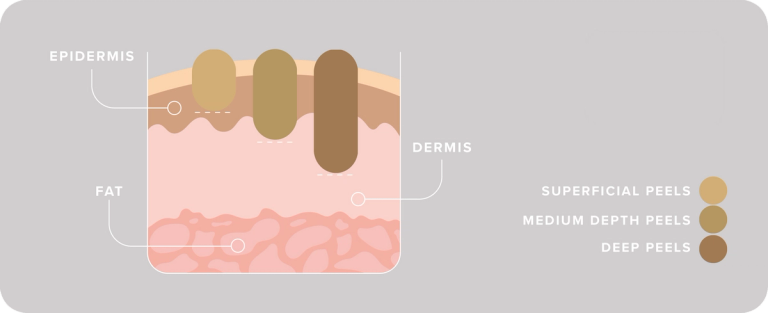
The best chemical peels in Oxford
We only feature the best chemical peels practitioners near you who we have vetted to ensure that they’re medically qualified, trained and insured. Click on their profile to read their real patients' reviews and to see their before and after photos.
At A Glance
Top Questions
Superficial Chemical Peels Overview
We are all familiar with mechanical exfoliation. Many people use facial scrubs, abrasive mitts or facial cleansing brushes to slough off dull skin cells.
Proper, regular exfoliation removes the barrier of dead skin cells on the surface of the skin, uncovering the fresh, new cells beneath. This clears the way for skincare products to penetrate more deeply into the skin, making them more effective.
Chemical peels are also another and more effective way of deeply, chemically exfoliating the skin. This is sometimes called chemiexfoliation and it reveals smoother, softer, more even skin.
Chemical peels, AKA skin peels, typically contain acids of varying strengths and types, which remove the dead, dull, outer layers of skin. The depth of the peel depends on the strength and type of acid used.

Superficial chemical peels are the mildest of the peels, they remove the outermost layer of the epidermis. They are mild enough to be used as part of a monthly skincare regime to help reduce the appearance of fine lines and age spots and can help even out the texture and tone of your skin.
This Glowday Treatment Guide has been edited and medically verified by Andrew Rankin.
How do superficial chemical peels work?
During a superficial chemical peel, acids are used to create an intentional, controlled injury to a specific skin depth. The acid breaks the chemical bonds which hold the skin cells together, causing them to peel off. Superficial peels remove all, or part of, the eipdermis.
The aim is to deeply exfoliate the skin, which in turn, stimulates new epidermal growth and collagen production, with more evenly distributed melanin. The new skin that grows has improved surface texture and appearance.
Acids commonly used for superficial peels include: lactic acid, glycolic acid, tartaric acid and salicylic acid. With the exception of salicylic acid (commonly used for acne treatments), these are known as the fruit acid peels.
Who are superficial chemical peels good for?
Superficial chemical peels are safe and effective for all skin types and tones. If you have uneven skin, blemishes, fine lines, sun damaged and blemished skin, a superficial chemical peel may help.
They can be used anywhere on the face, neck and body, and while they are most commonly used on the face, they are also a good option for those prone to acne on their chest and back.
They are used to:
- Smooth skin
- Reduce blemishes
- Reduce pigmentation
- Reduce the appearance of fine lines
- Improve the appearance of age spots
- Reduce the appearance of acne scarring
Chemical peels DO NOT reduce pore size or improve saggy, loose skin.
You may not be suitable for a chemical peel if you:
- are pregnant or breastfeeding
- have a history of problems with skin scarring, particularly keloid scarring
- have certain skin pigment issues, lesions or moles. These must be checked by a GP or dermatologist first.
- have facial warts or a facial skin infection
- have used prescription acne treatments such as isotretinoin
- have darkly pigmented skin (due to the heightened risk of hyperpigmentation)
- have had any other abrasive treatment, including home care treatments
- have recently exfoliated, shaved or waxed the area
You must inform your practitioner of all creams or facial products you have used.
How do you prepare for a superficial chemical peel?
1-2 weeks prior to your treatment, avoid adding anything new to your skincare routine. Specifically, avoid exfoliating facials, facial electrolysis and sunbathing/sunbed use.
3 days prior to your treatment, stop using active skin care products containing retinoic acid derivatives.
Your Superficial Chemical Peel Treatment
What should you do following a superficial chemical peel?
It is very important that you carefully follow the advice of your practitioner following a peel treatment to help improve the benefit of the procedure and reduce the risk of complications or side effects.
Following your chemical peel treatment, you should cleanse your face very gently with a soap-free cleanser, patting the skin dry with a towel. Ensure you moisturise your skin well.
2-4 days after your treatment you may experience peeling – though not everyone does. DO NOT pick or peel your skin. If you do, you risk bleeding, discolouration and even scarring.
Wear a high SPF sunscreen for at least 6 weeks post-treatment. This will reduce the risk of brown blotches (hyperpigmentation) forming on your skin.
What are the side effects and risks of superficial chemical peels?
As superficial chemical peels are the gentlest of the peels, you are less likely to experience an adverse reaction than with a medium-depth or deep peel.
- You may experience slight white discolouration in some areas or blotchy skin, though this should subside within a few hours.
- You may experience peeling 2-4 days after your treatment.
- Hyperpigmentation (brown spots on the skin) may occur with all peels, especially if your skin is darker. To reduce the chance of this, it is important to use creams as directed by your practitioner. This should include a high factor sunscreen daily.
- It is important to avoid direct sun exposure for 6 weeks post-peel.
- Cold sores – if you are susceptible to cold sores, you may find you have an outbreak after a chemical peel. To help prevent this, taking a course of antiviral medicine as advised by your practitioner beforehand may be advised.
- Redness – sometimes skin redness persists for more than 2-3 months, but this usually disappears in time.
How much do superficial chemical peels cost?
Prices start from £60 for a superficial peel, such as a glycolic or lactic acid peel.